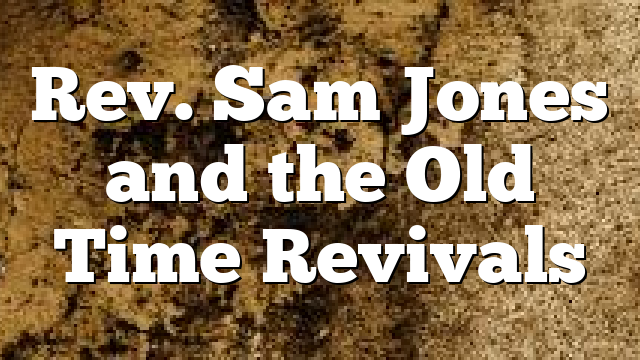Click to join the conversation with over 500,000 Pentecostal believers and scholars
Click to get our FREE MOBILE APP and stay connected
| PentecostalTheology.com



 The most famous and celebrated evangelist of his time, Sam Jones attracted a national congregation with style, wit and compelling delivery.
The most famous and celebrated evangelist of his time, Sam Jones attracted a national congregation with style, wit and compelling delivery.
Born: October 16, 1847 in Oak Bowery, Alabama
Died: October 15, 1906
Buried: Oak Hill Cemetery, Cartersville, Georgia
Married: Laura McElwain
At age nine, Sam moved to Cartersville, Georgia with his widowed father in 1856. He was taught by William and Rebecca Felton, and graduated with high honors from Euharlee Academy in 1867. At his father’s insistence, Jones studied for the bar at home and was admitted into the legal profession in 1868. Completely unsuccessful as a lawyer, Jones suffered mental depression and alcoholism, and worked menial jobs to support himself, his wife Laura McElwain, and young children.
A miraculous conversation at his father’s deathbed in August 1872 turned Jones’ life around and he entered the Methodist ministry. Jones managed several small Methodist circuits in Northwest Georgia until 1881, when he was appointed agent of the North Georgia Orphans Home, saving it from financial ruin by his evangelistic messages and personal magnetism. The appointment freed Jones from being tied down to local churches. His preaching flourished and his reputation grew as he traveled the state raising money for the orphanage.
In 1884, he was invited to preach a revival in Memphis, Tennessee which earned him high praise from the area newspapers and laid the foundation for his fame as a pulpit orator. Preaching in Nashville in 1885, Jones numbered among his converts the infamous river boat captain, Tom Ryman. Ecstatic in his new found faith, Ryman then built the Union Gospel Tabernacle for Jones and other revivalists. Upon Captain Ryman’s death, Jones suggested renaming the tabernacle in honor of his great friend. The Ryman Auditorium, or “Mother Church of Country Music” would become home of the Grand Ole Opry.
By 1886, at his own expense, Jones built a large open-air structure called “The Tabernacle” near his home in Cartersville. For 20 years until his death, thousands came annually to hear the great Sam Jones. He cared little for theological doctrine, emphasizing instead the simplicity of living a good life with a message as simple as ” quit your meanness.” While his flamboyant style attracted the favorable attention of the masses, it raised the ire of Methodist leaders, and in 1893, Jones split with the church, continuing to preach as an independent evangelist until his death in 1906.
Heading home to Cartersville from an engagement in Oklahoma City, Jones died on the train near Little Rock, Arkansas with his wife by his side. Thirty thousand mourners viewed the body as it lay in state at the rotunda of the Georgia State Capitol in Atlanta. Two thousand met the train in Marietta, Georgia and three thousand gathered at the depot in Cartersville, to welcome Jones home for the last time. Though he had many opportunities to make his home elsewhere, Jones remained a resident of Cartersville throughout his successful career. Today his home, Rose Lawn, is a house museum dedicated to his legacy and listed on the National Register of Historic Places.




Anonymous
A history found in the archives of the Sam Jones United Memorial Methodist Church suggests that the 1884 outside revival likely inspired his idea for the success that an open – air tabernacle could offer. He saw opportunity for reaching greater numbers of people and supplementing his income by using the revival as a tool to meet his calling.
Two years following the bush-arbor revival, Sam Jones proposed to the city of Cartersville to furnish him with ten acres of land on which he would build a tabernacle to preach the gospel. Records reflect that the city complied providing him with a property west of town where Sam Jones built the facility from his personal funds.
A June 17, 1886 article entitled, The Tabernacle, appeared in the Courant American newspaper and reported that a number of citizens met in the Opera House (Grand Theater vicinity) to consider Rev. Sam Jones’ proposal to erect a tabernacle. Business leaders attending the meeting realized the great good that would bring to the community if such an institution were established. The motion was approved; board of trustees appointed and work on the tabernacle began soon after. The trustees consisted of: R. H. Jones, R. M. Pattillo, W. H. Howard, J. T. Owen, T. W. Akin, S. L. Vandivere and E. D. Graham.
According to deed records the board assembled a tract of land in two separate purchases. The first was from Mr. Thomas W. Milner on September 16, 1886 in the amount of $500.00. A second purchase adjoining the first was made from Mr. William M. Graham on July 23, 1888 for $155.00. Interestingly, the trustees quickly conveyed a portion of Tabernacle land to the newly formed and incorporated Sam Jones Female College on November 4th, 1886.
Anonymous
John Mushenhouse William DeArteaga Roscoe Barnes III David Bundy David Willaim Faupel